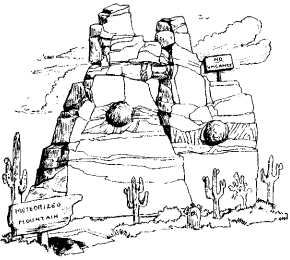
©1986 by Paul D. Ackerman http://www.creationism.org/books/ackerman/
 |
©1986 by Paul D. Ackerman http://www.creationism.org/books/ackerman/ |
|
2 - "Fossil" Meteorites For God is my King of old,
|
 |
There is another impressive timepiece that works on exactly the same principle as the cosmic-dust clock and thus provides an important verification of a recent creation. This clock deals not with tiny cosmic-dust particles but with larger chunks of space material known as meteors. A meteor is a chunk of rock that travels through space until it happens to fall into the path of the earth. When the meteor approaches the earth it makes contact with the atmosphere, and the resulting friction with atmospheric gas causes the meteoritic rock to heat up. As it heats up more and more, it begins to glow and finally burns with intense heat and light.
On a clear night these meteors are often visible as they streak across the sky. Most often such meteors are fairly small and completely burn up and disintegrate in the atmosphere before reaching the ground. However, some of them are able to survive long enough to reach the earth's surface, where they impact with tremendous force. Such bodies are then called meteorites, and they are recognizable not so much by their appearance but most importantly by their high nickel content. How do these meteorites form a clock?
A Rain Gauge
Consider a rain gauge and how it works. We have a container that is open at the top. When it rains a certain number of raindrops will just happen to hit the opening, and the water from these drops will collect in the container. We can then go out after it has stopped raining and tell how much it rained by measuring the amount of water in the container.
Although we would seldom want to do so, it is possible with a slight modification in procedure to turn the rain gauge into a kind of clock. Let us assume that we live in a location where it rains continuously and at a known rate. When we set a container outside under these circumstances we have a kind of clock, because we can assume that the more water in the container, the longer the container has been outside exposed to the steady shower of rain. If there is very little water, we know the container has not been out or opened for very long. If, on the other hand, there is much water, we know the container has been exposed to the rain for quite a while. Now, back to the matter of meteorites.
The Geologic Column as a Meteor-Shower Gauge
According to the theory of evolution and its requirement of eons of time for earth history, the "geologic column" has been gradually building up for hundreds of millions of years. The geologic column is the name geologists give to the layers of sedimentary rock we can see, for example, when a hill is cut away to make a roadbed for a highway. One of the most spectacular views of such stratified layers is provided by the Grand Canyon. Evolutionists believe that these rock layers have been building up gradually for millions of years.
If these millions of years were a reality there would have been countless numbers of meteors encountering the earth's atmosphere. As previously mentioned, the vast majority of these meteors would have burned up before reaching the ground, but a small percentage would reach the earth's surface each year as meteorites. With the passage of vast amounts of evolutionary time, these accumulating meteorites would be incorporated into the geologic column, and there should be many of them contained in the rock layers today. Paleontologists and other scientists doing research in the geologic rock layers should frequently encounter meteorites.
Most creationist scientists, however, do not believe that the geologic column has been building up, and thus been open to meteors, for millions of years. They argue, on the basis of a great deal of data and evidence, that the geologic column was laid down quickly under catastrophic conditions and thus has not been exposed to meteorites for very long. If this is the case, there would be very few meteorites in the geologic column and finding one would be a rare occurrence.
On the basis of the opposing recent-creation and evolution models, we have two distinctly different predictions about the number of meteorites in the geologic column. The evolution model predicts a high number of meteorites, which should turn up fairly often in geological research. Recent-creationists, by contrast, expect a very small number of meteorites in the geologic column. Thus, finding one should be an extremely rare event.
What do the data show? A clear result in favor of a recent creation.
One survey of the literature a few years ago failed to turn up a single
case of a meteorite being found in the geologic column.1
The meteorite clock reads clearly to the effect that the earth is not very
old.2
PREV NEXT Start of: "It's A Young World After All" www.creationism.org